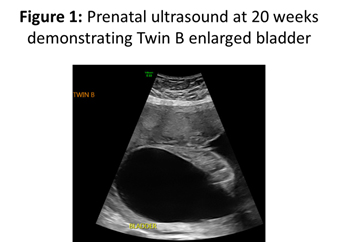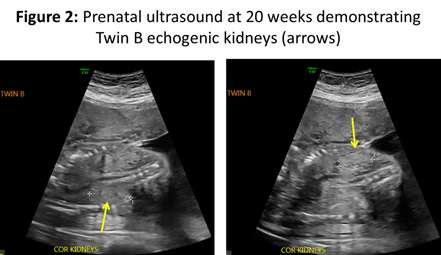Difficult decisions: fetal intervention in twin gestation
Bridget L. Findlay, M.D., Patricio C. Gargollo, M.D., Candace F. Granberg, M.D.
Mayo Clinic, Rochester, MN
A 36 year old G4P2103 woman with monochorionic diamniotic twin gestation was found to have antenatal bladder outlet obstruction (Figure 1) and oligohydramnios of Twin B on 20 week ultrasound. Bilateral kidneys also appeared to be echogenic (Figure 2). Twin A did not have any abnormalities. There was no history of congenital abnormalities with her other three children and no family history of urologic abnormalities or kidney disease.
Given the implications of bladder outlet obstruction, the patient opted for two rounds of vesicocentesis at 20w5d and 21w1d for Twin B. Urine biochemistry was significant for a markedly elevated Beta 2 microglobulin (>20,000), indicating severe renal damage. Chromosomal FISH/microarray studies were negative. Vesicoamniotic shunt was placed at 21w6d (Figure 3). She was admitted at 24w6d for premature rupture of membranes (PROM) and ultimately developed preeclampsia with severe features, which prompted Caesarean delivery at 30w1d. Twin B was 1090g at birth.
Shortly after delivery, he had respiratory distress due to suspected pulmonary hypoplasia requiring intubation. Renal ultrasound demonstrated a cystic, dysplastic right kidney and a markedly echogenic dysplastic left kidney that was not clearly visualized (Figure 4). He was anuric since birth. Attempt to place a 3.5Fr feeding tube into the urethra failed, suggesting urethral atresia. Additionally, he had an imperforate anus, complete absence of sigmoid colon and rectum, and sacral agenesis. Care was withdrawn on the 4th day of life in the setting of rising creatinine and anuria from severe kidney failure and he ultimately passed the following day.



Back to 2019 SFU Program




